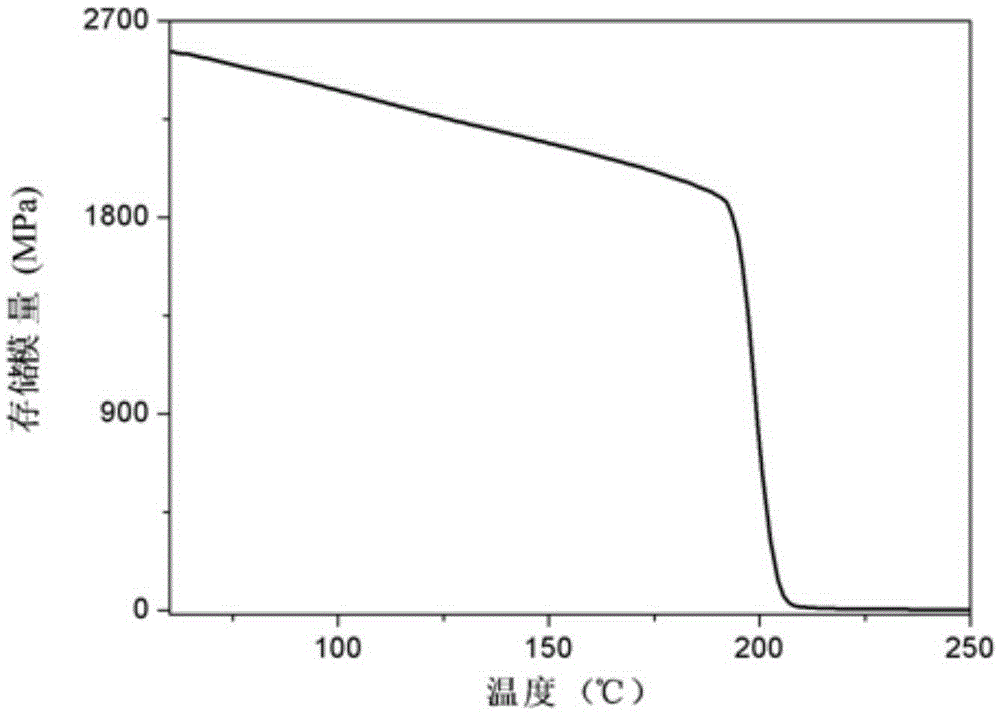Shape memory random-copolymerized polyimide capable of being circularly used and preparation method thereof
A polyimide and random copolymerization technology, applied in the field of polyimide and its preparation, can solve the problems that shape memory polyimide cannot be recycled and the cost of shape memory polyimide is high
- Summary
- Abstract
- Description
- Claims
- Application Information
AI Technical Summary
Problems solved by technology
Method used
Image
Examples
specific Embodiment approach 1
[0032] Embodiment 1: This embodiment is a recyclable shape memory random copolymer polyimide composed of 1,3-bis(3-aminophenoxy)benzene and bisphenol A diether dianhydride and 4 , prepared from a mixture of 4-oxydiphthalic anhydride; the 1,3-bis(3-aminophenoxy)benzene and bisphenol A diether dianhydride and 4,4-oxydiphthalic anhydride The molar ratio of the mixture of phthalic anhydride is 1:1; In the mixture of bisphenol A type diether dianhydride and 4,4-oxydiphthalic anhydride, bisphenol A type diether dianhydride and 4 , The molar ratio of 4-oxydiphthalic anhydride is A:B, the value range of A is 1≤A≤9, and the value range of B is 1≤B≤9.
[0033] The positive effect that this implementation mode has:
[0034] 1. In this embodiment, 1,3-bis(3-aminophenoxy)benzene is used as the diamine monomer, and a mixture of bisphenol A diether dianhydride and 4,4-oxydiphthalic anhydride is used as the diamine monomer. Dianhydride monomer to prepare recyclable random copolymerized shap...
specific Embodiment approach 2
[0040] Specific embodiment two: This embodiment is a preparation method of recyclable shape-memory random copolymerized polyimide is completed according to the following steps:
[0041] 1. Add 1,3-bis(3-aminophenoxy)benzene into the aprotic polar solvent, and then stir it under a dry nitrogen atmosphere until the 1,3-bis(3-aminophenoxy)benzene is completely Dissolving to obtain diamine solution;
[0042] The volume ratio of the amount of 1,3-bis(3-aminophenoxy)benzene described in step 1 to the aprotic polar solvent is 0.05mol:(80mL~130mL);
[0043] 2. Dissolving the mixture of bisphenol A type diether dianhydride and 4,4-oxydiphthalic anhydride in an aprotic polar solvent to obtain a dianhydride solution;
[0044] In the mixture of bisphenol A type diether dianhydride and 4,4-oxydiphthalic anhydride described in step 2, the mixture of bisphenol A type diether dianhydride and 4,4-oxydiphthalic anhydride The molar ratio is A:B, the value range of A is 1≤A≤9, and the value ran...
specific Embodiment approach 3
[0050] Specific embodiment three: the difference between this embodiment and specific embodiment two is: the aprotic polar solvent described in step one is N,N-dimethylformamide, N,N-dimethylacetamide or N-Methylpyrrolidone. Other steps are the same as in the second embodiment.
PUM
| Property | Measurement | Unit |
|---|---|---|
| thickness | aaaaa | aaaaa |
| glass transition temperature | aaaaa | aaaaa |
| storage modulus | aaaaa | aaaaa |
Abstract
Description
Claims
Application Information
 Login to View More
Login to View More - R&D
- Intellectual Property
- Life Sciences
- Materials
- Tech Scout
- Unparalleled Data Quality
- Higher Quality Content
- 60% Fewer Hallucinations
Browse by: Latest US Patents, China's latest patents, Technical Efficacy Thesaurus, Application Domain, Technology Topic, Popular Technical Reports.
© 2025 PatSnap. All rights reserved.Legal|Privacy policy|Modern Slavery Act Transparency Statement|Sitemap|About US| Contact US: help@patsnap.com



